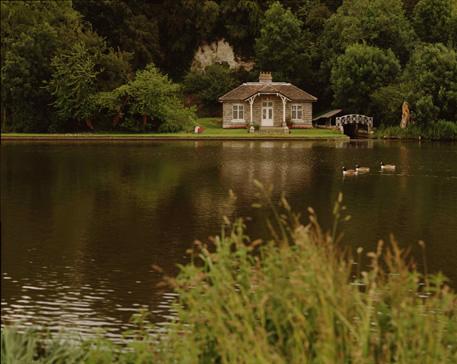
Photograph copyright ©1999 - 2018 Denis Waugh.
External Links
HENLEY
The lady in the Henley Tourist Information Centre has never heard of him - I suppose because people nowadays are more interested in the famous Henley Regatta - but just for the record, I think we should remember the thirteenth-century agricultural writer Walter of Henley.
Walter advised farmers to bring seed from the manors at Michaelmas because 'Seed grown on other ground will bring more profit than that which is grown on your own.'
He offered proof, too: `Plough two selions at the same time and sow one with seed which is bought and the other with corn which you have grown; in August you will see that I speak truly.'
Now I don't know how large an area a selion is - and I don't know anyone who knows it either, and I would hate to be accused of nagging, but I do find it extraordinary that a person can have been so perspicacious regarding seed in the thirteenth century, and yet it was to be five hundred years before Jethro Tull perfected the seed drill.
But back to modern day Henley, noted for sartorial elegance and rowing: in that order. Charles Dickens would have been fifteen years old when the first Oxford and Cambridge Boat Race was rowed between Hambledon and Henley in 1829. He called Henley `the Mecca of the rowing man' and might have added `and the fashionable woman' because the outfits on display during regatta week are rather more beautiful than sporting, with picture hats, white gloves, pretty frocks and parasols, like participants in a Monet painting. There is always - and doubtless there will always be -controversy between fashion victims and the press because it's all good fun and cheap copy. The first Henley regatta proper was held in 1839 and it became Royal in 1851 with Prince Albert as patron.
From the regatta starting point, downriver by Temple Island, you can see the sixteenth-century tower of St Mary's Church with its four pinnacles pointing skyward. The rest of the church dates from earlier and its outbuildings include the lovely little timbered fourteenth-century Chantry house. This is the oldest building in Henley in daily use, a parish lady tells me proudly. Today the Mothers' Union are doing parish lady things with teapots and potted plants but an invitation is issued to me to look upstairs and I accept with alacrity.
With its old timbered roof and its herring-bone brick-and-timber walls it seems that this must be one of the oldest buildings in the whole country in daily use. The information on the noticeboard would seem to indicate that it has been so for about six hundred years: sometimes as a school, sometimes a chapel and sometimes an annexe to the Red Lion Hotel which has at various times entertained Charles I, the Duke of Marlborough and Johnson and Boswell.
There is a monument to Chancellor Bacon's sister, Lady Elizabeth Periam, in the church, commemorating her three marriages: to Robert D'Oyley, Henry Nevill and finally William Periam. One wonders how much choice she had in her marriages, as rich widows seem to have been bought and sold as commodities by monarchs, but I hope her influential brother saw to her well-being. At any rate, she was able to do useful things with her money, as in 1609 she founded a dame school in the lower room of the chantry house. She also founded a school for the education of 20 poor boys of the town and is thus accounted the chief benefactress of the Grammar School (now King James's College of Henley) and a yearly sermon, attended by the pupils, is still preached in her honour. Elizabeth also founded a fellowship and two scholarships at Balliol and past generations of Oxford academics might be deeply ashamed to think that women were admitted to Balliol as students only in 1979.
Text copyright ©1999 - 2018 Priscilla Waugh.